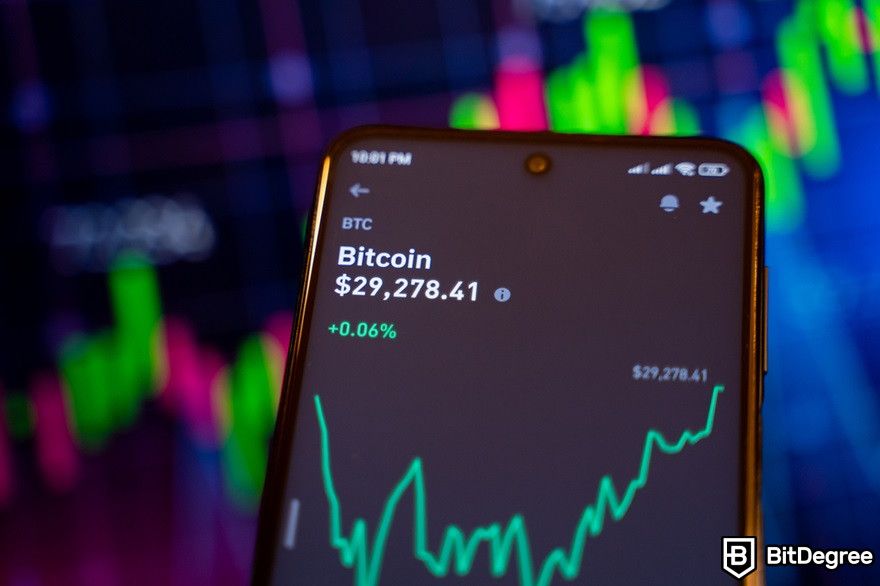Key Takeaways
- Crypto bear markets are inevitable. Prices might crash and people might get scared, but remember, historically, these downtimes always end and things go back up eventually;
- Learning how to earn money in a crypto bear market can be valuable to navigate the downtime. Some strategies include diversifying your bear market investments and setting limit order before buying or selling crypto;
- Investing in cryptocurrencies, especially during a bear market, carries inherent risks. Always factor in your risk tolerance and financial goals before making any investments.
Stop overpaying - start transferring money with Ogvio. Sign up, invite friends & grab Rewards now! 🎁
Let's face it, the crypto world is a rollercoaster ride. It's thrilling, with the potential for high rewards, but just like any other investment, this volatile landscape can experience periods of decline known as the crypto bear market. The downturn can cause panic, but fear not! Being prepared can make all the difference.
Understanding the signs and how to earn money in a crypto bear market can give you the confidence to weather the storm. While others fear the worst, you can use this uncertain period to strategically invest and potentially grow your portfolio even further.
One way to be prepared for the crypto bear market, or any market condition, is by taking control of your assets. Here's where a hardware wallet like Ledger Nano X comes in. It’s a secure and user-friendly hardware wallet to store your cryptocurrencies offline, away from online vulnerabilities.

Did you know?
Subscribe - We publish new crypto explainer videos every week!
Where to Trade Crypto: 3 Best Approaches Explained (Animated)


Table of Contents
- 1. What is a Bear Market?
- 1.1. Bear VS Bull Market
- 2. How to Make Money in a Crypto Bear Market
- 2.1. Earn Without Spending: BitDegree Missions
- 2.2. HODL
- 2.3. Short Selling
- 2.4. Portfolio Diversification
- 2.5. Hedging
- 2.6. Limit Buy and Stop-Loss Order Usage
- 3. Tips for Portfolio Management During a Bear Market
- 4. Is Crypto in a Bear Market?
- 5. Conclusions
What is a Bear Market?
A bear market in finance refers to a prolonged period of decline in investment prices. So, what is a bear market in crypto? The crypto bear market translates to a similar downturn, where cryptocurrency prices experience a sustained drop, often exceeding 20% from recent highs. This decline can influence the entire crypto market and individual assets.
Latest Deal Active Right Now:Both traditional and crypto bear markets are characterized by a prolonged decline in asset prices.
However, in their most characteristic way, crypto prices are like a rollercoaster – they can go up and down faster and steeper than traditional markets. This could potentially be a chance for high-risk investors to buy cryptocurrency "at a discount”.
Fear and pessimism dominate investor sentiment during a bear market in both traditional and crypto markets. This can lead to panic selling, pushing prices down even harder.
Still, unlike traditional markets that close at night and on weekends, the crypto market operates 24/7/365, which can make things even worse. This constant trading can spread news fast, especially when social media and crypto forums are full of people talking about it. Bad news can fly around even faster, making people more scared and unsure.

If we talk about rules and standards, traditional stock markets are heavily regulated, which can provide some stability during downturns. Crypto markets, on the other hand, are less regulated, making them potentially more susceptible to manipulation and scams during bear markets.
More importantly, the crypto space is constantly evolving, with new projects and regulations all the time. New ideas are great in the long run, but during a bear market, these can make things even more confusing for investors. They might hesitate to invest in new projects or established ones facing technological disruptions.
So, is a bear market good or bad? It depends on your investment goals and time horizon. Bear markets can be challenging for short-term investors hoping for quick gains. However, they can also present opportunities for long-term investors to buy quality assets at potentially lower prices.
Bear VS Bull Market
The bear market is when many aspects go down – prices are falling, investors are pessimistic, and the trading activity may decrease or become volatile. When considering bear market investments, many people prioritize stability over growth. They focus on either holding onto their existing assets or selling to avoid further losses.
Meanwhile, the bull market is when everything goes up – prices are rising, investors are optimistic, trading activity increases, and many people want to buy assets because of their growth potential.

One thing to remember is that bull and bear markets come and go, they’re part of the normal investment cycle. While the crypto bear market can be unsettling, it eventually ends, and the market rebounds.
However, the volatile nature of this period makes people question: can you make money in crypto bear market, when everything seems uncertain? Don't be surprised – some investors see these downturns as golden opportunities!
By employing strategies like dollar-cost averaging (DCA) or staking, they can accumulate crypto at lower prices, potentially positioning themselves for gains when the market recovers.
How to Make Money in a Crypto Bear Market
We've talked about the basic idea of the crypto bear market – falling prices and gloomy forecasts. I guess a question pops up: can you make money in crypto bear market? As I said, yes, there's still hope. Even in a challenging climate, there are ways to potentially earn profits. Let's explore some strategies in more detail to keep your crypto portfolio thriving, even when the market's down.
Just note that this is not a financial advice. Before making any big investment decisions, it would be best to consult with a financial advisor.
Earn Without Spending: BitDegree Missions
In a bear market, jumping into risky trades or investments might not be the smartest move, especially if you’re just starting out or want to play it safe. Because let's face it, bear markets aren’t the easiest time to make money in crypto. But here’s the good news: you don’t actually need to invest any money to start earning with BitDegree Missions.
They’re basically gamified learning tasks that reward you with real crypto, NFTs, or platform perks. Think quizzes, short challenges, or trying out a new platform—stuff you can do in a few minutes, and actually learn something useful along the way.

Even better? BitDegree often runs seasonal events, like Airdrop Season 7, where the more Missions you complete, the more rewards you can unlock from prize pools worth tens of thousands of dollars. And yes—you can qualify just by being active, not by investing.
So while everyone else is panic-selling or sitting on the sidelines, you could be quietly stacking tokens and building the skills you’ll need when the market turns around. Later on, the crypto you earn now could play right into other bear market strategies—like HODLing or diversifying into promising projects, without having to buy in at all. Perfect, right? I know!
HODL
The term HODL originated from a misspelling of "hold" in a 2013 online forum post. Although some say it stands for “hold on for dear life”, this term essentially emphasizes a long-term buy-and-hold strategy[1]. In this case, investors choose to hold onto their assets, ignoring short-term price swings, with the expectation of big price appreciation in the future.
HODLing goes beyond simply “holding”. It's a mindset that prioritizes long-term growth over short-term gains. HODLers believe in the underlying potential of cryptocurrencies and are willing to go through the inevitable ups and downs of the market.
There are several benefits of HODLing:
- Discipline and patience. HODLing encourages investors to avoid impulsive decisions based on market uncertainty.
- Cost averaging. By consistently buying crypto at various price points, HODLers can average out their purchase cost over time.
- Potential for significant gains. Historically, cryptocurrencies have shown significant long-term growth. HODLing allows investors to potentially benefit from this increase.
HODLing can be a good plan, but it's not for everyone. You'll need to be comfortable with some risk and plan to hold your crypto for a long time. This is only one of the several methods on how to make money in crypto bear market. It's still crucial to research individual projects and understand the inherent risks associated with the market before deciding to use this strategy.
Short Selling
If you're a seasoned investor comfortable with high-risk strategies, short selling can be your bold approach on how to make money in a crypto bear market. It's a speculative technique that aims to profit from a decline in the price of a cryptocurrency.

The basic idea is that you borrow a specific amount of cryptocurrency from a broker or exchange and immediately sell on the market at the current price (let's call it "Price A"). Then, you hope that the price will go down.
Once the price falls (let's say it gets to "Price B"), you buy back the same amount of cryptocurrency you borrowed to repurchase it and return it to the lender. You return the borrowed crypto to the lender. The difference between the selling price (Price A) and the buying price (Price B) is your profit
Example:
- You borrow 1 Ethereum (ETH) when the price is $1,000 (Price A).
- The price of ETH drops to $500 (Price B).
- You buy back 1 ETH at $500 and return it to the lender.
- Your profit is $500 (Price A - Price B) minus any fees.
When prices are falling in a bear market, short sellers have the potential to make significant profits if their predictions are accurate. The higher volatility than the usual market can create more opportunities for short sellers to enter and exit positions strategically.
Note that short selling is very risky – it's generally not recommended for beginner crypto investors. If the price goes up instead of down like your prediction, you could experience big losses. Moreover, not all cryptocurrency exchanges offer short selling due to its complexity and potential risks.

Did you know?
Subscribe - We publish new crypto explainer videos every week!
What is Ethereum 2.0? Upgrades Easily Explained With Animations


Portfolio Diversification
A crypto bear market can be a nerve-wracking time for investors. Seeing your portfolio value drop can tempt you to panic sell and retreat entirely. So, a question naturally arises: can you make money in crypto bear market the easy way? The answer is yes with portfolio diversification.
Spreading your crypto investments across different currencies is crucial[2]. Many investors avoid putting all their eggs in one basket because a single cryptocurrency has a higher risk, so diversifying the portfolio helps lessen the overall risk.
Alternatively, allocate your bear market investments across different asset classes (stocks, bonds, crypto). This means that if one asset class or specific investment performs poorly, the losses are potentially offset by gains (or smaller losses) in others.

Typically, bear markets don't affect all asset classes equally. While some asset classes might be slumping, others might hold steady or even experience growth. Crypto might be a volatile choice when investing in a down market, while established assets like bonds or certain stablecoins can offer more stability
Here are some specific diversification strategies for a crypto bear market:
- Increase allocation to stable assets. Consider increasing your allocation to more stable assets like bonds and cash equivalents. These can act as a buffer against major losses in riskier assets.
- Dollar-Cost Averaging. This strategy involves investing a fixed amount of money into your chosen assets at regular intervals, regardless of the price[3]. This helps you average out the cost per share over time, potentially mitigating the impact of short-term price fluctuations during a bear market.
- Explore alternative investments. While traditional stocks and bonds are good options, consider diversifying further with other investments like real estate or commodities. These can have a lower correlation with traditional markets, potentially offering some protection during a bear market.
Every now and then, check your investment mix to make sure it still fits your risk tolerance and investment goals. During a bear market, some of your investments might have dropped more than others. To even things out again, you may need to buy more of the ones that go down in price.
Hedging
Essentially, hedging involves taking an opposite position in a related asset to offset potential losses in your primary investment. This strategy typically provides traders with a form of insurance to protect themselves from a possible major loss.
One common hedging technique is future contracts. These are agreements to buy or sell crypto at a specific price on a predetermined future date, aiming to lock in a selling price regardless of what the price is on that date.

The main benefit of this technique is it protects you from some of the risks associated with investing in a down market. If the price falls below your agreed-upon selling price in the future, you'll still make money on the sale because you locked in a higher price earlier.
The downside is that you miss out on those potential profits because you're locked into selling at a lower price if the price goes up in the future.
Imagine you own Ethereum (ETH) and you're worried about a price drop. You could use a futures contract to lock in a selling price for your ETH at $1,000 in three months. This protects you if the price falls below $1,000 in that timeframe.
However, if the price of ETH goes up to $1,500 in three months, you'd miss out on those additional gains because you're locked into selling at the lower price you set earlier.
Another hedging method is option contracts. These are similar to futures contracts, but with more flexibility because you purchase the right, but not the obligation, to sell your crypto at a certain price by a specific date.

It offers more flexibility than futures contracts. If the price drops, you can exercise your option to sell at the agreed-upon price to limit your losses. However, if the price goes up, you can let the option expire and potentially make more money by selling your crypto at a higher market price.
Note that option contracts cost money upfront (the premium), even if you don't sell your crypto.
If you want more flexibility in your crypto futures trading, you can choose perpetual contracts with no expiration date. Instead of settling the contract with cash or crypto on a specific day, perpetual contracts use a system of fees and rebates to keep the market price of each contract in balance.
It’s like a tug-of-war between those who think an asset's price will go up (longs) and those who think it will go down (shorts).
When the price falls, the "shorts" who are essentially betting against the asset pay a fee to the "longs" who are right. This fee system encourages people to take the opposite side of a trade, automatically adjusting market demand to keep the price of the perpetual contract stable.

- Secure and reliable
- Accepts fiat currencies
- Lots of trading options
- Reputable exchange
- Accepts fiat currencies
- Offers various trading options

- Huge trading variety
- Regulation-compliant around the globe
- Fair trading fees
- Beginner-friendly
- A wide array of features
- Vast number of different crypto coins & tokens

- Beginner-friendly
- Secure
- Decent trading and withdrawal fees
- Crypto.com Visa Card
- Automated tools & bots
- Ecosystem synergy with CRO
Limit Buy and Stop-Loss Order Usage
While the crypto market can be unpredictable, limit and stop-loss orders become even more valuable strategies during a bear market.
Limit orders allow you to set a buy limit price lower than the current market price. This way, you can potentially scoop up crypto at a discount if the price drops to your desired level.
For example, Ethereum (ETH) is trading at $1,500. You believe it might drop further due to the bear market, so you set a buy limit order for ETH at $1,200. If the price falls to $1,200 or even lower, your order will be filled, potentially allowing you to get ETH at a cheaper price.
Meanwhile, a stop-loss order is like telling your exchange to automatically sell your investment if the price goes down to a certain point you set. This helps you limit how much money you lose if the market drops.

Imagine you bought Bitcoin (BTC) for $10,000 before the bear market hit. You're worried about the price dropping further, so you set a stop-loss order for BTC at $8,000.
If the price of BTC stays above $8,000, your stop-loss order isn't triggered, and you can hold onto your Bitcoin. However, if the price of BTC falls to $8,000 or lower, your stop-loss order is automatically executed. This means your exchange will sell your Bitcoin at the next available market price.
The stop-loss order guarantees your sale happens at $8,000 or lower, but it doesn't guarantee the exact price you'll get. The market price might be slightly lower than $8,000 depending on supply and demand at that specific moment.
You can also use stop-loss orders to lock in profits by setting a price above your purchase. If the price rises, your order won't be triggered. However, if the price starts to fall, the stop-loss order sells your crypto, potentially protecting some of your profits.

For instance, you bought Ethereum (ETH) at $1,200 and set a stop-loss order at $1,400. If the price of ETH continues to rise above $1,400, your stop-loss order won't be triggered, and you can let your profits grow even further.
However, if the market takes a turn and the price of ETH starts to fall back down, your stop-loss order will automatically sell your ETH at the next available market price once it reaches $1,400 (or lower). This helps you protect some of the profits you made by selling at a higher price point than your purchase price.
In short, you can use a limit order before you buy or sell crypto to get a specific price for your buy or sell transaction. Meanwhile, you can use a stop-loss order after you've already bought crypto to automatically limit your potential losses (for long positions) or lock in profits (for short positions).
Tips for Portfolio Management During a Bear Market
In this last section, I've outlined some key strategies for navigating a crypto bear market. Now, let's explore practical tips you can implement to manage your portfolio effectively during this volatile time.
The first and most important tip is to only invest as much as you can afford to potentially lose entirely. Although considered a common investment principle, this applies even more during a bear market. This means don't use the money you need for rent, groceries, bills, upcoming emergencies, or any other short-term financial needs.

Cryptocurrencies can be very volatile, and their prices can fluctuate significantly. If you invest money you need soon, you might be forced to sell at a loss if the price drops. In other words, invest with "play money", not the money you rely on.
Don't get caught up in short-term price fluctuations. Focus on the long-term potential of the crypto projects you hold.
Then, learn and prepare for the next cycle. Bear markets can be a great time to learn and refine your investment strategies. Read industry publications, take online courses, and stay updated on project developments. The knowledge you gain can position you well for (hopefully) the bull cycle or even the next crypto bear market.
I also suggest that you perform due diligence before investing in a down market or any market condition.
Don't blindly invest in every trending cryptocurrency during a bull market. In a bear market, due diligence becomes even more crucial. Thoroughly research new projects, assess their development progress, and understand their market niche before deciding to put your money on it.

Besides focusing on the external factors, the internal ones are also important.
Clearly define your financial goals for your crypto investments. Are you looking for short-term gains or long-term portfolio growth? Having clear goals helps you make informed decisions during a bear market. For example, if your goal is long-term growth, you might be more willing to hold onto your investments during a price dip, believing in their long-term potential.
Additionally, assess your risk tolerance. How comfortable are you with potential losses? A bear market is not the time to take excessive risks. Stick to an investment strategy that aligns with your risk profile
Finally, especially during volatile times, it's essential to store your crypto assets securely. Consider using reputable hardware wallets to keep your private keys offline and away from potential hackers.
Is Crypto in a Bear Market?
Is crypto in a bear market or is the bear market over? Determining whether the bear market is over or we're in the thick of it needs analyzing several economic indicators and market trends.
Generally, here are the key indicators of a bear market:
- Price drops. A sustained decline in cryptocurrency prices across the market is a major sign. This could be a slow and steady decrease or a series of sharp drops.
- Decreased trading volume. Lower trading volume suggests a decline in investor interest and overall market activity. This can indicate a lack of confidence and buying pressure.
- Negative news and sentiment. Bear markets are often accompanied by negative news articles, social media sentiment, and FUD (fear, uncertainty, and doubt) spreading among investors.
- Increased volatility. While cryptocurrencies are inherently volatile, a significant increase in price swings can be a sign of a bear market. Prices might become more unpredictable and experience larger fluctuations.
- Investor panic selling. As prices drop and fear spreads, some investors might panic and sell their holdings, further driving down prices and creating a downward spiral.
If we want to see the pattern, the market experienced several bear markets throughout the cryptocurrency history.

One notable example was around 2011 when Bitcoin, the leading cryptocurrency, experienced a major crash due to some factors including exchange hacks (e.g., Mt. Gox), market immaturity, and regulatory uncertainty. The asset dropped from around $32 in June 2011 to under $2 by November 2011, marking an over 90% decline.
Then, a longer and more severe bear market began in December 2013 and lasted until around August 2015. During this period, Bitcoin's price dropped by around 84%. This bear market was attributed to several factors, including the aforementioned Mt. Gox hack being fully revealed, a crackdown on Bitcoin by Chinese authorities, and a general decline in investor sentiment.
Another significant bear market occurred in 2018, with Bitcoin's price falling by over 80% from its all-time high reached in December 2017. This crash was likely caused by a combination of factors, including increased regulation, security concerns, and a lack of real-world adoption of cryptocurrencies.
While many say the average bear market length can be around several months, these historical examples show how the actual duration can be much longer and more severe, demanding patience, collected decision-making, and a long-term investment strategy.

So, the question is: What’s happening now and how do we connect the crypto bear market’s key indicators and history with the current events? Is crypto in a bear market now?
As of mid-2024, opinions and analyses are mixed regarding the state of the bear market and the potential for a bull market, although some areas show positive sentiments.
A report by the Independent suggests that Bitcoin's price could surge significantly in the next year. Analysts at Bitomat, a company that operates cryptocurrency ATMs, believe a combination of two factors could drive this growth: the Bitcoin halving in April 2024 that saw its supply constricted and increased demand due to the approval of Bitcoin ETFs by US regulators.
Based on this analysis, Bitomat's analysts predict Bitcoin's price could reach anywhere between $130,000 and $220,000 by 2025. For your information, a month before the Bitcoin halving, the cryptocurrency reached an all-time high at $73,844, surpassing previous records.

Well, if we’re allowed to be optimistic, previous halvings in 2012, 2016, and 2020 have each been followed by substantial bull markets within the following year.
Even more good news, the crypto world is seeing some exciting changes. For example, the European Union's MiCA (Markets in Crypto-Assets) aims to provide a comprehensive regulatory framework for digital assets, increasing transparency and consumer protection, and encouraging crypto innovations in the EU. The rules should be in full effect by December 2024.
Despite the optimism, several factors in 2024 have raised concerns about a potential crypto bear market. For instance, continued interest rate hikes by central banks, like the Federal Reserve, to combat inflation could reduce market liquidity. Higher interest rates typically lead investors to shy away from riskier assets like cryptocurrencies.
Conclusions
The crypto world is exciting, but even rollercoasters have dips. A crypto bear market, with falling prices and scary headlines, can feel like a sudden snowstorm. Faced with this chilly climate, you may wonder, “Is a bear market good or bad?”. The answer actually depends!
Having the right methods of investing in a down market helps keep you calm because you've considered the risks and have a strategy to manage them. With the right strategies I’ve discussed above, you might even find opportunities to grow your portfolio. Still, always factor in your risk tolerance and financial goals before making any bear market investments.
In such periods in crypto, if you want to avoid all the risk, you may also want to check out BitDegree Missions, as it can be a way to earn crypto without spending a dime.
Ledger Nano X is a security-focused tool to navigate the market drop. It's a hardware wallet that allows you to store cryptocurrencies offline, away from online vulnerabilities. This can be especially crucial during volatile market periods where hacking attempts might increase.
The content published on this website is not aimed to give any kind of financial, investment, trading, or any other form of advice. BitDegree.org does not endorse or suggest you to buy, sell or hold any kind of cryptocurrency. Before making financial investment decisions, do consult your financial advisor.
Scientific References
1. A. Urquhart: 'Under the Hood of the Ethereum Blockchain';
2. W. Abdelmalek: 'Cryptocurrencies and Portfolio Diversification Before and During COVID-19';
3. J. L. Kirkby, S. Mitra, D. Nguyen: 'An Analysis of Dollar Cost Averaging and Market Timing Investment Strategies'.









